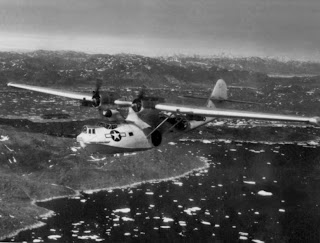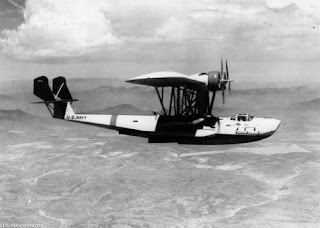There was a great need for aircraft that could take off and land on water. This was especially needed for the Pacific Ocean region for transport between Pacific Ocean islands.
In the early 1930's it became quite apparent that the Japanese were expanding their empire in both Asia and the Pacific and a modernized sea based aircraft would be needed. They were correct. it would be needed and probably sooner than they thought.
The answer for the U.S. government was the legendary PBY Catalina aircraft.
Advantages of the PBY Catalina
It's obvious that an aircraft that can take off and land on water offers a big strategic advantage. These aircraft were designed and manufactured back in 1931 such as the PBY pictured at left.
The problem with these earlier versions was that the range was too short and the capacity and weaponry capabilities had to be improved. Another strategic reason for water based craft was that back in the 1930's and 1940's there wasn't an overabundance of concrete runways and when you consider that much of their use would be on or adjacent to oceans, a dependable and capable long range water based patrol bomber was much needed. The development of the large Pan Am Clippers that operated in the Pacific and South America during this era attests to the practicality of sea based aviation. The PBY Catalina was developed along the same years as the Pan Am Martin Flying Boats.
Designing the PBY
The government asked for competing prototypes from both Consolidated Aircraft and Douglas Aircraft. The prototype adopted was the Consolidated XP3Y which had it's maiden flight in March 1935. After it's maiden flight the plane was turned over to the Navy for their trials. In October 1935 the Navy returned the plane to Consolidated with a list of desired enhancements including more powerful engines. Even though the Navy asked for enhancements, the Consolidated plane was superior to any current flying boat in use.
Interestingly enough, the somewhat redesigned and enhanced XPBY-1 had it's maiden flight in May 1936 and during this flight a new long distance record of 3,443 miles was achieved. This was certainly an aircraft capable of operating over vast oceans. The PBY in various models were flown by several allied governments including Australia and Great Britain. In fact, restored PBY's are even flown today.
PBY Specs

The Consolidated PBY Catalina did much of it's work at speeds of 100-125 MPH and with full fuel tanks and efficiently tuned engines the aircraft could stay airborne for about 30 hours. This allowed the PBY to have a remarkable service range.
The photo at right is a PBY-5A equipped with radar flying over Greenland in 1945. The planes dimensions were 63 ft 10 in length, 104 ft wingspan, 20 ft. 2 in height and powered by two Pratt and Whitney Radial Engines each with 1,200 horsepower. Maximum speed was 196 MPH with a cruising speed of 125 MPH. It's offocial range was 2,520 miles with a service ceiling of 15,800 ft.
PBY World War Two Service
The wartime service of this most versatile aircraft was legendary. With it's superior range and ability to land on the ocean, the aircraft was an efficient rescue vehicle for downed fliers. There were many TBM-Avenger torpedo bomber pilots successfully picked up from the ocean by PBY rescue aircraft during World War Two. With it's range, the PBY's patrolling capabilities were superior.
The aircraft was constantly used to search for enemy warships as well as enemy submarines operating right off our U.S. coastline. The PBY was one of the aircraft used to search for German U-Boats operating in the Gulf of Mexico. The U-Boats had good success sinking allied oil tankers off Louisiana and Texas during 1942-43 and the PBY's were used extensively. The PBY's virtually saw service in every World War Two theater of conflict. From Greenland to Alaska to the South Pacific..the PBY's were involved. This multi-role aircraft served with every arm of the military. The Navy, the Army Air Forces and then with the United States Air Force.
You will also find interesting our Western Trips article and photos of the UH-1 Huey helicopter with "Lucy in the Skies" detailing.
While the PBY was probably the most resourceful aircraft aloft, it did have one flaw. Flying during the daylight hours in the South Pacific, the plane was a good target for the fast and highly maneuverable Japanese Zero fighters. While the PBY certainly had range and superior load capacity, it lacked the measure of maneuverability needed to effectively dodge enemy fighters.

The PBY was designed with a retractable landing gear which added greatly to it's versatility. When World War Two began Consolidated Aircraft became much more busy with a government contract for 782 additional PBY-5's. The planes were constructed in New Orleans and Canada.
After Pearl Harbor, PBY's were stationed out of Alameda California for the purpose of patrolling 800 miles off the U.S. west coast searching for any possible Japanese submarines and surface vessels.
Additionally, the PBY was used for mapping in Alaska and for establishing the LORAN navigation system throughout the Pacific theater. Add to that the fact that PBY's were employed to rescue downed airmen in the Pacific Ocean such as during the crucial Battle of Midway. Likewise the PBY was used extensively on both rescue missions and recon patrol during campaigns in the Solomon and Mariana Islands.
This was one magnificent wartime aircraft and one of the very best places to see the PBY on display is at the Seaplane Base at Oak Harbor, Whidbey Island, Washington. Prior to and during the war PBY pilots trained off Whidbey Island. At the onset of the war there was real concern about the security of both the Pacific northwest and Alaska.
The photo above left is a PBY flying over the Aleutian Islands during 1943. A seaplane base was established at Dutch Harbor in the Aleutians to help protect Alaska. The PBY on display at Whidbey Island was once stationed there. Currently there are plans to put upwards of $150,000 into it's restoration depending mostly on donations. The naval aircraft memorial was established in 1998 and the acquisition of the PBY aircraft spanned some twelve years. The plane was received in 2010. The Seaplane Base will also have Naval aircraft from 1942 and later on display. If all of this isn't enough, the Whidbey Island Washington museum also has a flight simulator you can try out. A visit to the Naval Aviation Memorial at Whidbey Island is a fun and educational trip for the whole family.
You will also enjoy our photo article on the Beechcraft 18 which is in flying condition andon display at the Western Antique Aeroplane and Automobile Museum.
See the PBY on Display
If you're on a western U.S. road trip there are a few additional sites to see the PBY on display. A good vacation stopover is the San Diego Air and Space Museum at Balboa Park in San Diego California. Many World War Two aircraft are on display including the PBY Catalina and a restored Japanese Zero.
Another growing aircraft museum which has a PBY on display is the Minnesota Wing Confederate Air Force at Fleming Field, Hangar 3 in South St. Paul Minnesota.
A road trip to see and photograph the amazing PBY could be a fun and educational addition to your vacation or weekend getaway.
Another very interesting aviation story is that of Wiley Post and his record setting Lockheed Vega.
(Photos from the public domain)


